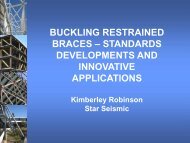Environmental Impacts of Multi-Storey Buildings Using Different ...
Environmental Impacts of Multi-Storey Buildings Using Different ...
Environmental Impacts of Multi-Storey Buildings Using Different ...
You also want an ePaper? Increase the reach of your titles
YUMPU automatically turns print PDFs into web optimized ePapers that Google loves.
- 16 -recycling and use <strong>of</strong> demolition waste for the further displacement <strong>of</strong> fossil fuels – in thecase <strong>of</strong> wood, by burning waste materials.• Compare the New Zealand Green Star Office rating tool with LCA results to check forconsistency, and make recommendations as to possible improvements to the Office ratingtool.• Engage an accredited Green Star consultant to provide a review <strong>of</strong> the comparisonbetween LCA and Green Star.• Determine and report on the type <strong>of</strong> timber used in construction and maintenance <strong>of</strong> thefour building designs and the source <strong>of</strong> this timber, together with any applicablesustainable source certification.• Broadly determine the amount and level <strong>of</strong> treatment <strong>of</strong> timber used in the constructionand maintenance <strong>of</strong> the four building designs, with emphasis on the use <strong>of</strong> CCAtreatments.• Report on the current status for burning treated wood.3.2 Research TeamThe University <strong>of</strong> Canterbury (UC) was in a unique position to lead this research.• UC is at the forefront <strong>of</strong> research into innovative design <strong>of</strong> large-scale, multi-storeycommercial timber buildings.• Existing research (from March 2007) at UC mirrored the proposed MAF-fundedresearch.The University <strong>of</strong> Canterbury provided overall project management and engaged a number <strong>of</strong>other research establishments and specialist consultants to provide expert information andadvice.In order to fulfil the Research Objectives, the research was organised in a number <strong>of</strong> distinctsub-programmes (with main contributors shown);• Structural design <strong>of</strong> Timber, TimberPlus, Concrete and Steel buildings; UC andothers.• Architectural design <strong>of</strong> building; Victoria University <strong>of</strong> Wellington.• Assessment <strong>of</strong> quantities <strong>of</strong> materials in each building by Quantity Surveyor, DavisLangdon Shipston Davies <strong>of</strong> Christchurch.• Operational energy modelling and analysis <strong>of</strong> all four buildings; N. Perez, VUW.• Life cycle assessment (LCA) <strong>of</strong> alternative building designs; Scion.• Assessment and review <strong>of</strong> timber use in Timber buildings; Warren and Mahoney,Christchurch.3.3 Government Policies Supporting ResearchListed below is a summary <strong>of</strong> the government directives around sustainable buildingpractices. These directives have supported the growing interest (“push”) for moreinformation, consideration and action on construction <strong>of</strong> commercial and large-scale timberbuildings in New Zealand.
















